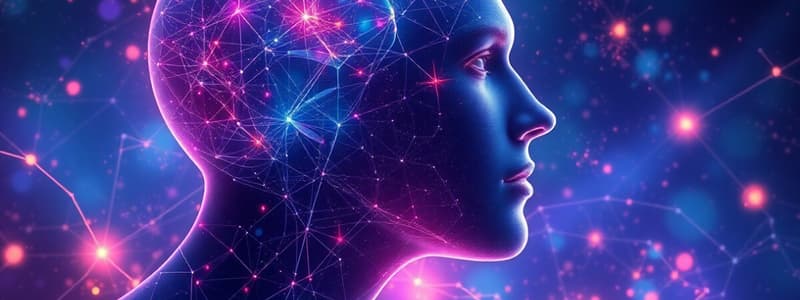Podcast
Questions and Answers
What is the primary function of basal cells in the olfactory epithelium?
What is the primary function of basal cells in the olfactory epithelium?
- Producing mucus to trap odorants
- Detecting odorant molecules
- Regenerating olfactory receptor neurons (correct)
- Providing structural support to neurons
Which structure acts as the first relay station in the olfactory pathway?
Which structure acts as the first relay station in the olfactory pathway?
- Limbic system
- Olfactory tract
- Primary olfactory cortex
- Olfactory bulb (correct)
What is the role of Bowman's glands in olfaction?
What is the role of Bowman's glands in olfaction?
- To secrete hormones for signal transduction
- To transmit signals to the olfactory bulb
- To trap and dissolve odorants (correct)
- To generate new olfactory receptors
The axons from olfactory receptor neurons synapse with which types of cells in the olfactory bulb?
The axons from olfactory receptor neurons synapse with which types of cells in the olfactory bulb?
Which of the following is NOT a region associated with processing olfactory information in the brain?
Which of the following is NOT a region associated with processing olfactory information in the brain?
What type of receptors are olfactory receptors?
What type of receptors are olfactory receptors?
Which intracellular signaling pathway is primarily activated by olfactory receptor stimulation?
Which intracellular signaling pathway is primarily activated by olfactory receptor stimulation?
What is the significance of the limbic system in relation to olfaction?
What is the significance of the limbic system in relation to olfaction?
What is the primary effect of Na⁺ and Ca²⁺ influx in olfactory receptor cells?
What is the primary effect of Na⁺ and Ca²⁺ influx in olfactory receptor cells?
Which type of papillae is primarily involved in the perception of food texture?
Which type of papillae is primarily involved in the perception of food texture?
What is the primary mechanism for detecting salty taste?
What is the primary mechanism for detecting salty taste?
Which cranial nerve is responsible for taste sensations in the posterior one-third of the tongue?
Which cranial nerve is responsible for taste sensations in the posterior one-third of the tongue?
Which taste sensation is triggered by G protein-coupled receptors?
Which taste sensation is triggered by G protein-coupled receptors?
What is the primary function of the cornea in the human eye?
What is the primary function of the cornea in the human eye?
What physiological process is best described by 'pupil constriction'?
What physiological process is best described by 'pupil constriction'?
Where are taste buds NOT found in the mouth?
Where are taste buds NOT found in the mouth?
Which structure of the eye is responsible for changing shape to focus light onto the retina?
Which structure of the eye is responsible for changing shape to focus light onto the retina?
Which sequence correctly describes the main pathway of taste signals in the brain?
Which sequence correctly describes the main pathway of taste signals in the brain?
What causes the release of neurotransmitters in gustatory cells?
What causes the release of neurotransmitters in gustatory cells?
Which type of photoreceptor cell is primarily responsible for detecting color?
Which type of photoreceptor cell is primarily responsible for detecting color?
What area of the brain receives visual information from the thalamus?
What area of the brain receives visual information from the thalamus?
What is the function of the optic chiasma?
What is the function of the optic chiasma?
What is the primary cause of myopia?
What is the primary cause of myopia?
Which eye condition is caused by an irregularly shaped cornea or lens?
Which eye condition is caused by an irregularly shaped cornea or lens?
What is the primary cause of increased intraocular pressure in glaucoma?
What is the primary cause of increased intraocular pressure in glaucoma?
Which of the following is NOT a common symptom of Meniere's disease?
Which of the following is NOT a common symptom of Meniere's disease?
What is a potential treatment option for managing glaucoma?
What is a potential treatment option for managing glaucoma?
How does increased intraocular pressure affect vision in glaucoma?
How does increased intraocular pressure affect vision in glaucoma?
Which structure is primarily affected in Meniere's disease?
Which structure is primarily affected in Meniere's disease?
What is the primary cause of vision loss in glaucoma?
What is the primary cause of vision loss in glaucoma?
Which part of the ear is primarily responsible for amplifying sound vibrations?
Which part of the ear is primarily responsible for amplifying sound vibrations?
What role do hair cells in the Organ of Corti play in the hearing process?
What role do hair cells in the Organ of Corti play in the hearing process?
Which structure in the inner ear is involved in maintaining equilibrium?
Which structure in the inner ear is involved in maintaining equilibrium?
What does the saccule and utricle sense in the vestibular system?
What does the saccule and utricle sense in the vestibular system?
Which component of the ear is mainly responsible for converting sound waves into electrical impulses?
Which component of the ear is mainly responsible for converting sound waves into electrical impulses?
What is the anatomical role of the auricle in hearing?
What is the anatomical role of the auricle in hearing?
How do movements of the head affect the semicircular canals?
How do movements of the head affect the semicircular canals?
Which cranial nerve is primarily responsible for transmitting taste information from the anterior two-thirds of the tongue?
Which cranial nerve is primarily responsible for transmitting taste information from the anterior two-thirds of the tongue?
In which part of the brain is the primary olfactory cortex located?
In which part of the brain is the primary olfactory cortex located?
Which structure in the eye is responsible for controlling the shape of the lens to focus light on the retina?
Which structure in the eye is responsible for controlling the shape of the lens to focus light on the retina?
What is the function of the Organ of Corti in the cochlea?
What is the function of the Organ of Corti in the cochlea?
Which type of papillae on the tongue do not contain taste buds but are involved in texture perception?
Which type of papillae on the tongue do not contain taste buds but are involved in texture perception?
What role do G protein-coupled receptors play in taste detection?
What role do G protein-coupled receptors play in taste detection?
What initiates the process of phototransduction in the retina?
What initiates the process of phototransduction in the retina?
What is the final result of the phototransduction process in photoreceptors?
What is the final result of the phototransduction process in photoreceptors?
Flashcards
Olfactory Receptors
Olfactory Receptors
Bipolar neurons located in the olfactory epithelium, responsible for detecting odorant molecules.
Basal cells
Basal cells
Stem cells in the olfactory epithelium that constantly replace olfactory receptor neurons, which have a limited lifespan.
Supporting Cells
Supporting Cells
Support cells in the olfactory epithelium that provide structure and metabolic support to olfactory receptors and maintain a stable ionic environment.
Bowman's Glands
Bowman's Glands
Signup and view all the flashcards
Olfactory Bulb
Olfactory Bulb
Signup and view all the flashcards
Olfactory Tract
Olfactory Tract
Signup and view all the flashcards
Primary Olfactory Cortex
Primary Olfactory Cortex
Signup and view all the flashcards
Limbic System
Limbic System
Signup and view all the flashcards
Olfactory Transduction
Olfactory Transduction
Signup and view all the flashcards
Olfactory Receptor Cells
Olfactory Receptor Cells
Signup and view all the flashcards
Depolarizing Generator Potential (Olfactory)
Depolarizing Generator Potential (Olfactory)
Signup and view all the flashcards
Taste Buds
Taste Buds
Signup and view all the flashcards
Gustatory Receptor Cells
Gustatory Receptor Cells
Signup and view all the flashcards
Umami Taste
Umami Taste
Signup and view all the flashcards
Sour Taste
Sour Taste
Signup and view all the flashcards
Sweet Taste
Sweet Taste
Signup and view all the flashcards
What is the cornea?
What is the cornea?
Signup and view all the flashcards
What is the pupil?
What is the pupil?
Signup and view all the flashcards
What is the lens?
What is the lens?
Signup and view all the flashcards
What is the retina?
What is the retina?
Signup and view all the flashcards
What are rods?
What are rods?
Signup and view all the flashcards
What are cones?
What are cones?
Signup and view all the flashcards
What is the optic chiasma?
What is the optic chiasma?
Signup and view all the flashcards
What is the occipital lobe?
What is the occipital lobe?
Signup and view all the flashcards
Cochlea
Cochlea
Signup and view all the flashcards
Organ of Corti
Organ of Corti
Signup and view all the flashcards
Semicircular Canals
Semicircular Canals
Signup and view all the flashcards
Ampulla
Ampulla
Signup and view all the flashcards
Crista Ampullaris
Crista Ampullaris
Signup and view all the flashcards
Maculae
Maculae
Signup and view all the flashcards
Vestibular System
Vestibular System
Signup and view all the flashcards
Sound Transmission
Sound Transmission
Signup and view all the flashcards
Glaucoma
Glaucoma
Signup and view all the flashcards
Meniere's Disease
Meniere's Disease
Signup and view all the flashcards
Cornea
Cornea
Signup and view all the flashcards
Pupil
Pupil
Signup and view all the flashcards
Lens
Lens
Signup and view all the flashcards
Which cranial nerve carries taste from the anterior tongue?
Which cranial nerve carries taste from the anterior tongue?
Signup and view all the flashcards
Where is the primary olfactory cortex located?
Where is the primary olfactory cortex located?
Signup and view all the flashcards
What controls the lens shape in the eye?
What controls the lens shape in the eye?
Signup and view all the flashcards
What structure detects sound frequency?
What structure detects sound frequency?
Signup and view all the flashcards
Which papillae are responsible for texture?
Which papillae are responsible for texture?
Signup and view all the flashcards
How do GPCRs work in taste?
How do GPCRs work in taste?
Signup and view all the flashcards
Explain phototransduction in rods and cones.
Explain phototransduction in rods and cones.
Signup and view all the flashcards
What is phototransduction?
What is phototransduction?
Signup and view all the flashcards
Study Notes
Olfaction (Sense of Smell)
- Olfactory Receptors are bipolar neurons located in the olfactory epithelium of the nasal cavity
- They detect odorant molecules
- Basal Cells are stem cells that regenerate olfactory receptor neurons, which have a short lifespan
- Supporting Cells provide structural and metabolic support to olfactory receptor neurons, maintaining ionic environment for signal transduction
- Bowman's Glands produce mucus that traps and dissolves odorants, facilitating detection by olfactory receptors
- Olfactory Bulb is a brain structure where olfactory receptor neuron axons synapse with mitral and tufted cells.
- It is the first relay station in the olfactory pathway
- Olfactory Tract carries signals to various brain regions, including the primary olfactory cortex, the limbic system, and the hypothalamus
- Primary Olfactory Cortex processes olfactory information and perception, and is related to the emotional and memory impact of smells.
- Hypothalamus links olfactory signals to autonomic responses like salivation and appetite regulation
- Odorants trigger a cascade of intracellular events when binding to olfactory receptors
- G Protein-Coupled Receptors (GPCRs) are olfactory receptors
- The cAMP Pathway is activated by odorants, increasing cAMP levels.
- This leads to the opening of ion channels, causing a depolarizing generator potential.
- Depolarizing Generator Potential results in the influx of sodium and calcium ions, generating an action potential
- The potential travels along the olfactory nerve to the brain
Taste (Gustation)
- Taste Buds contain gustatory receptor cells found on papillae of the tongue, soft palate, and epiglottis
- Foliate, Filiform, Fungiform, and Circumvallate Papillae are different types of papillae with varying numbers of taste buds
- Taste Sensations include Umami (savory, glutamate), Sour (acidic, H+ ions), Sweet (sugars, GPCRs), Bitter (alkaloids, GPCRs), and Salty (sodium ions, ion channels)
- Signal Transduction involves direct passage of ions for salty and sour tastes and GPCR activation for sweet, bitter, and umami tastes, causing depolarization and neurotransmitter release
- Cranial Nerves (VII, IX, X) transmit taste signals to the brain
- Taste signals travel to the medulla oblongata, then the thalamus, hypothalamus, limbic system, and the primary gustatory area in the cerebral cortex.
Vision
- Cornea focuses light onto the retina; pupil controls the amount of light entering the eye; and the lens changes shape to focus light onto the retina
- Retina contains photoreceptor cells (rods and cones) which receive and convert light into electrical signals
- Rods are for black-and-white vision in low light
- Cones detect color and provide high-acuity vision in bright light
- Pathway light enters the cornea travels through the pupil and lens, and focuses onto the retina
- Optic Nerve transmits visual information to the brain
- Optic Chiasma is where the optic nerves partially cross
- Optic Tracts carry visual information to the thalamus
- Thalamus relays visual information to the occipital lobe and visual cortex
- Phototransduction involves opsin and retinal; light changes retinal shape which activates opsin; initiates a cascade leading to the generation of an action potential.
Hearing and Equilibrium
- External Ear funnels sound waves
- Middle Ear amplifies sound and transmits vibrations
- Inner Ear consists of cochlea, semicircular canals, saccule, and utricle
- Cochlea converts sound vibrations into electrical signals
- Organ of Corti within the cochlea contains hair cells that detect different sound frequencies
- Semicircular Canals detect rotational movements of the head
- Saccule and Utricle detect linear acceleration and head position.
- Vestibular System provides balance and spatial orientation signals to the brain
- Hearing and equilibrium relies on hair cell stimulation by mechanical means. Data from these structures are sent to the brain for balance and spatial awareness.
Studying That Suits You
Use AI to generate personalized quizzes and flashcards to suit your learning preferences.





